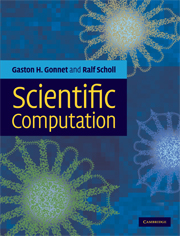Book contents
- Frontmatter
- Contents
- Preface
- List of abbreviations
- 1 Determination of the accurate location of an aircraft
- 2 When to replace equipment
- 3 Secondary structure prediction using least squares and singular value decomposition
- 4 Secondary structure prediction using least squares and best basis
- 5 Secondary structure prediction with learning methods (nearest neighbors)
- 6 Secondary structure prediction with linear programming (LP)
- 7 Stock market prediction
- 8 Phylogenetic tree construction
- Appendix A Methods for function minimization
- Appendix B Online resources
- Index
1 - Determination of the accurate location of an aircraft
Published online by Cambridge University Press: 17 February 2011
- Frontmatter
- Contents
- Preface
- List of abbreviations
- 1 Determination of the accurate location of an aircraft
- 2 When to replace equipment
- 3 Secondary structure prediction using least squares and singular value decomposition
- 4 Secondary structure prediction using least squares and best basis
- 5 Secondary structure prediction with learning methods (nearest neighbors)
- 6 Secondary structure prediction with linear programming (LP)
- 7 Stock market prediction
- 8 Phylogenetic tree construction
- Appendix A Methods for function minimization
- Appendix B Online resources
- Index
Summary
In this chapter we want to find the most accurate location of an aircraft using information from beacons. This is essentially the same problem that a GPS system or a cellular phone has to solve.
Topics
Non-linear least squares
Statistical errors
Function minimization
Sensitivity analysis
The chapter is organized as follows:
in Section 1.1 the problem is described,
in Section 1.2 we will show how to model this problem mathematically,
in Section 1.3 we will solve it analytically, and
in Section 1.4 we will explore methods to analyze the solution we have found.
In Appendix A we explore different minimization methods.
Introduction
Figure 1.1 illustrates a simplified typical situation of navigation with modern aircraft. The airplane is in an unknown position and receives signals from various beacons. Every signal from the beacons is assumed to contain some error. The main purpose of this problem is to develop a method for computing the most likely position of the aircraft based on all the information available.
We distinguish two kinds of beacons: very high frequency omnirange (VOR) and distance measuring equipment (DME). The VOR beacons allow the airplane to read the angle from which the signal is coming. In other words, θ1, θ2 and θ3 are known to the airplane. The DME beacon, using a signal that is sent and bounced back, allows the distance from the airplane to the beacon to be measured.
- Type
- Chapter
- Information
- Scientific Computation , pp. 1 - 13Publisher: Cambridge University PressPrint publication year: 2009

